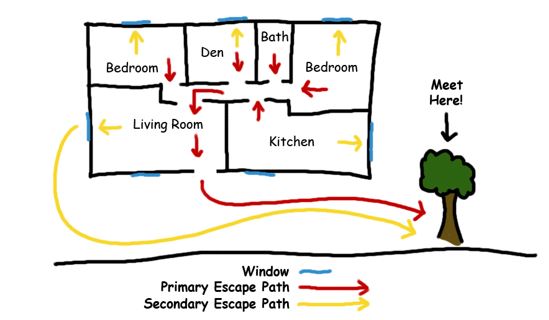Home Escape Plan
When a fire occurs, there is no time to waste. That is why it is so important to sit down with your family today and make a step-by-step plan for escaping from a fire.

Draw a floor plan of your home, marking two ways out of every room - especially sleeping areas. Discuss the escape routes with every member of your household and agree on a meeting place outside your home where every member of the household will gather to wait for the fire department. This allows you to count heads and inform the fire department if anyone is trapped inside the burning building. Everyone is encouraged to practice your escape plan at least twice a year. Have a fire drill in your home. Appoint someone to be a monitor and have everyone participate. A fire drill is not a race; get out quickly, but carefully and be sure to make your exit drill realistic. Pretend that some exits are blocked by fire and practice alternative escape routes, pretend that the lights are out and that some escape routes are filling with smoke.
Print out an Escape Plan Template here.
Make sure everyone in the household can unlock all doors and windows quickly, even in the dark. Windows or doors with security bars need to be equipped with quick-release devices and everyone in the household should know how to use them.
If you live in an apartment building, use stairways to escape. Never use an elevator during a fire. It may stop between floors or take you to a floor where the fire is burning.
If you live in a two storey house, and you must escape from a second storey window, be sure there is a safe way to reach the ground. Make special arrangements for children, older adults and people with disabilities. People who have difficulty moving should have a phone in their sleeping area and, if possible, should sleep on the ground floor.
Test doors before opening them. While kneeling or crouching at the door, reach up as high as you can and touch the door, the knob and the space between the door and its frame with the back of your hand. If the door is hot, use another escape route. If the door is cool, open it with caution.
If you are trapped, close all doors between you and the fire. Stuff the cracks around the doors with towels or blankets to keep out smoke. Wait at a window and signal for help with a light coloured cloth or a flashlight. If there is a phone in the room, call 911 and tell the operator exactly where you are.
In case of fire, do not stop for anything. Do not try to rescue possessions or pets. Go directly to your meeting place and then call the fire department from a neighbour's phone. Every member of your household should know how to call the fire department.
Crawl low under smoke. Smoke contains deadly gases and heat rises. During a fire, cleaner air will be near the floor. If you encounter smoke when using your primary exit, use your alternate escape plan. If you must exit through smoke, crawl on your hands and knees keeping your head 12 to 24 inches (30 to 60 cm) above the floor.
Once you are out of your home, do not go back for any reason. If people are trapped, firefighters have the best chance of rescuing them. The heat and smoke of a fire are overpowering. Firefighters have the training, experience and protective equipment needed to enter burning buildings.
More than half of all fatal home fires happen at night while people are asleep. Smoke alarms are set off when a fire starts, alerting people before they are trapped or overcome by smoke. With smoke alarms, your risk of dying in a home fire is cut nearly in half. Install smoke alarms outside every sleeping area and on every level of your home, including the basement. Test smoke alarms monthly. Change all smoke alarm batteries at least once a year. If your smoke alarm is more than 10 years old, replace it.
